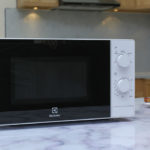Microwaves have become invaluable allies for those short on time, now a staple in most households and used for cooking, but most often for reheating food in a matter of seconds.
The speed at which microwaves operate is due to the particular waves “activating” the molecules in our food, but are we really certain that it is the best cooking method beyond being the fastest? How do microwaves truly work? Can you really cook everything in a microwave? This article will reveal the tips and secrets of a wonderful appliance that has changed the way we cook forever.
1. How do microwaves work?
Unlike classic ovens where heat is conducted and radiated, microwaves generate heat from the impact of waves on the water molecules present in food. The molecules are “shaken” by the microwaves, starting to move and reaching very high temperatures while warming or cooking the food. This style of cooking saves time: all the heat remains inside the food and none is lost.

2. Is defrosting food in the microwave really good?
Apart from reheating precooked food or cooking meals from scratch, microwaves are often used to defrost food in a matter of minutes: you might be sorry to know that this is actually a bad habit.
In fact, according to some studies, defrosting too quickly promotes the growth of naturally occurring bacteria, especially in meat and fish: freezing tends to break down most of these bacteria, however, if “awakened” too quickly, bacteria can multiply and may cause uncomfortable stomach aches, if not something more serious.
So, how do we defrost food not too slowly but in a way that is beneficial to our health? It is simpler than we think: experts talk about the “cold chain” or a process in which food gradually endures higher temperatures: the safest way to defrost food is to place it in the fridge so it slowly softens. Also, take note: never refreeze defrosted food, you risk “awakening” double the bacteria in the food.
3. What foods can be reheated in the microwave?
What we can cook as well as reheat in the microwave, certainly results in simple, nutritious, and tasty meals? Whatever you plan to cook in the microwave, always pay attention to using the right type of container so as not to ruin the food. In the microwave, you can cook vegetables (except for green leafy ones) and sauces, taking care not to seal the container too tightly, meat (veal, pork, or stews) will be especially tasty and tender when cooked without fat.

4. Foods that cannot be reheated in the microwave
The microwave is considered a wonder tool and a solver of all our problems: but not all foods can be cooked in the microwave. Here are some foods that should not be put in the microwave and why:
Chicken: white meat may contain some bacteria that are not always eliminated when cooked in the microwave; it is better to choose the traditional cooking method which may take longer but will be more effective.
Potatoes: if you want to reheat cooked potatoes, the microwave is not the best method to use. In fact, at room temperature, potatoes can develop Clostridium botulinum bacteria that electromagnetic waves cannot eliminate. It is best to use a pan, oven, or air fryer.
Rice: rice contains a large amount of starch which means that after cooking it must be eaten immediately or stored in the fridge to prevent it from turning sour; in fact, if left at room temperature, rice becomes a breeding ground for bacteria that the microwave cannot defeat.
Green leafy vegetables: green leafy vegetables (spinach, asparagus…) contain nitrates which in themselves are not dangerous to our bodies, however, these molecules can become carcinogenic when exposed to electromagnetic waves. So it is better not to cook them in the microwave.
Breast milk and baby food: the increase in waves moving the molecules present in the milk destroys some of the nutritional properties of the milk.
Chili peppers: unfortunately, if cooked or heated in the microwave, chili peppers can develop toxins and become harmful to our bodies.

5. Which food containers should not be used in the microwave?
Nowadays, it is easy to find suitable containers for cooking or reheating our meals in the microwave. However, always remember the materials that should never be used in the microwave:
First of all are metal containers, when placing this type of container in the microwave, the electromagnetic waves will reflect and damage the interior of the cavity.
Also, do not use low-quality plastic containers as they may release harmful substances into our food when subjected to electromagnetic waves.
Last but not least: do not use paper containers as they may catch fire, except for ready-made food containers that are clearly labeled as microwave-safe on the packaging.
According to Nhịp Sống Việt







































